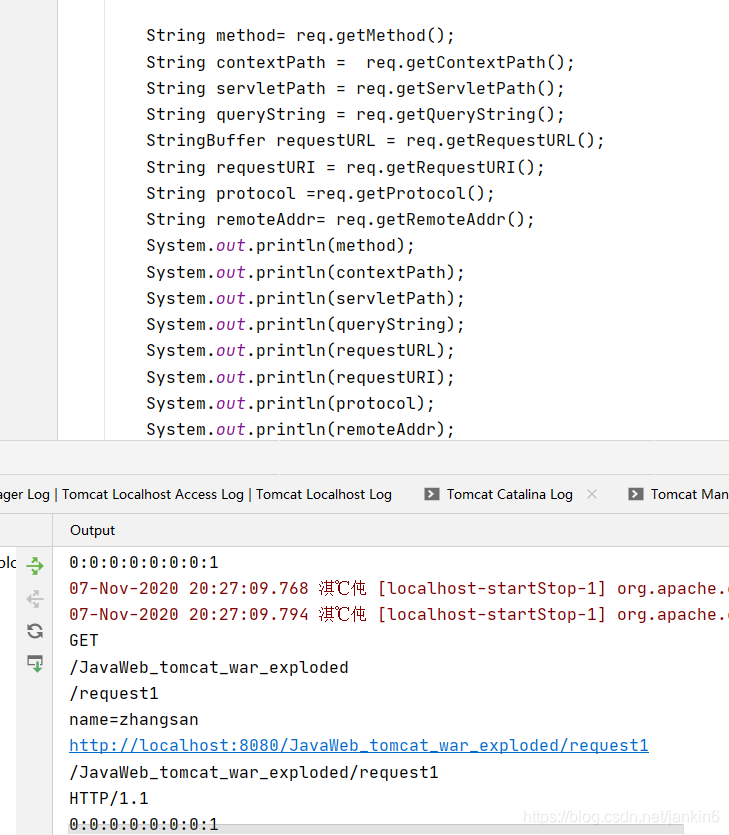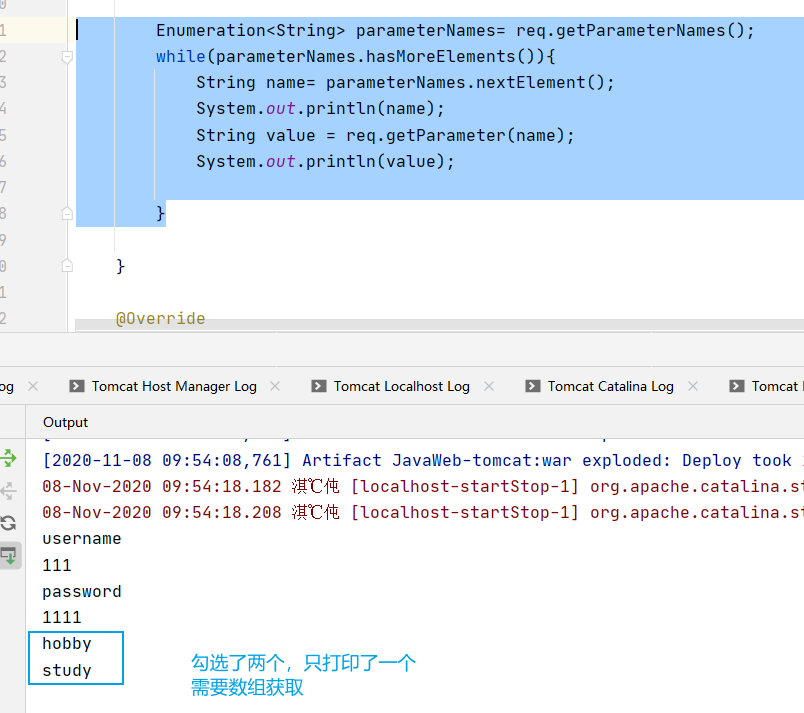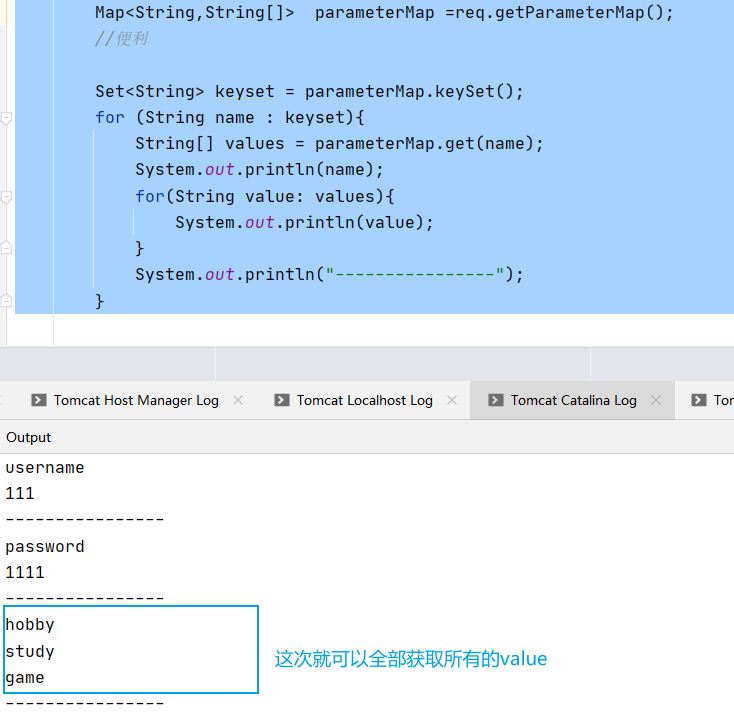细说HTTP-request
HTTP概念:
Hyper Text Transfer Protocol 超文本传输协议
传输协议:定义了,客户端和服务器端通信时,发送数据的格式
特点:
1. 基于TCP/IP的高级协议
2. 默认端口号:80
3. 基于请求/响应模型的:一次请求对应一次响应
4. 无状态的:每次请求之间相互独立,不能交互数据
- 1
- 2
- 3
- 4
历史版本:
1.0:每一次请求响应都会建立新的连接
1.1:复用连接
- 1
- 2
请求消息数据格式
1. 请求行
请求方式 请求url 请求协议/版本
GET /login.html HTTP/1.1
- 请求方式:
HTTP协议有7中请求方式,常用的有2种
- GET:
1. 请求参数在请求行中,在url后。
2. 请求的url长度有限制的
3. 不太安全 - POST:
1. 请求参数在请求体中
2. 请求的url长度没有限制的
3. 相对安全
2. 请求头:客户端浏览器告诉服务器一些信息
请求头名称: 请求头值
- 常见的请求头:
-
User-Agent:浏览器告诉服务器,我访问你使用的浏览器版本信息
* 可以在服务器端获取该头的信息,解决浏览器的兼容性问题 -
Referer:http://localhost/login.html
告诉服务器,我(当前请求)从哪里来?
作用:
1. 防盗链:
2. 统计工作:
3. 请求空行
空行,就是用于分割POST请求的请求头,和请求体的。
4. 请求体(正文):
封装POST请求消息的请求参数的
> username=zhangsan
- 1
字符串格式:
POST /login.html HTTP/1.1
Host: localhost
User-Agent: Mozilla/5.0 (Windows NT 6.1; Win64; x64; rv:60.0) Gecko/20100101 Firefox/60.0
Accept: text/html,application/xhtml+xml,application/xml;q=0.9,*/*;q=0.8
Accept-Language: zh-CN,zh;q=0.8,zh-TW;q=0.7,zh-HK;q=0.5,en-US;q=0.3,en;q=0.2
Accept-Encoding: gzip, deflate
Referer: http://localhost/login.html
Connection: keep-alive
Upgrade-Insecure-Requests: 1
- 1
- 2
- 3
- 4
- 5
- 6
- 7
- 8
- 9
- 10
- 11

Request
-
request对象和response对象的原理
1. request和response对象是由服务器创建的。我们来使用它们
2. request对象是来获取请求消息,response对象是来设置响应消息 -
request对象继承体系结构:
ServletRequest -- 接口
| 继承
HttpServletRequest -- 接口
| 实现
org.apache.catalina.connector.RequestFacade 类(tomcat)
- 1
- 2
- 3
- 4
- 5
- request功能:
1. 获取请求消息数据
1. 获取请求行数据
* GET /day14/demo1?name=zhangsan HTTP/1.1
- 方法:
1. 获取请求方式 :GET
* String getMethod()
2. (*)获取虚拟目录:/day14
* String getContextPath()
3. 获取Servlet路径: /demo1
* String getServletPath()
4. 获取get方式请求参数:name=zhangsan
* String getQueryString()
5. (*)获取请求URI:/day14/demo1
* String getRequestURI(): /day14/demo1
* StringBuffer getRequestURL() :http://localhost/day14/demo1
* URL:统一资源定位符 : http://localhost/day14/demo1 中华人民共和国
* URI:统一资源标识符 : /day14/demo1 共和国
6. 获取协议及版本:HTTP/1.1
* String getProtocol()
7. 获取客户机的IP地址:
* String getRemoteAddr()
- 1
- 2
- 3
- 4
- 5
- 6
- 7
- 8
- 9
- 10
- 11
- 12
- 13
- 14
- 15
- 16
- 17
- 18
- 19
- 20
- 21
- 22

protected void doGet(HttpServletRequest req, HttpServletResponse resp) throws ServletException, IOException {
String method= req.getMethod();
String contextPath = req.getContextPath();
String servletPath = req.getServletPath();
String queryString = req.getQueryString();
StringBuffer requestURL = req.getRequestURL();
String requestURI = req.getRequestURI();
String protocol =req.getProtocol();
String remoteAddr= req.getRemoteAddr();
System.out.println(method);
System.out.println(contextPath);
System.out.println(servletPath);
System.out.println(queryString);
System.out.println(requestURL);
System.out.println(requestURI);
System.out.println(protocol);
System.out.println(remoteAddr);
}
GET
/JavaWeb_tomcat_war_exploded
/request1
name=zhangsan
http://localhost:8080/JavaWeb_tomcat_war_exploded/request1
/JavaWeb_tomcat_war_exploded/request1
HTTP/1.1
0:0:0:0:0:0:0:1
- 1
- 2
- 3
- 4
- 5
- 6
- 7
- 8
- 9
- 10
- 11
- 12
- 13
- 14
- 15
- 16
- 17
- 18
- 19
- 20
- 21
- 22
- 23
- 24
- 25
- 26
- 27
- 28
- 29
- 获取请求头数据
* 方法:
(*)String getHeader(String name):通过请求头的名称获取请求头的值
Enumeration<String> getHeaderNames():获取所有的请求头名称
protected void doGet(HttpServletRequest req, HttpServletResponse resp) throws ServletException, IOException {
//1,获取请求头数据
//Enumeration 就可以理解为一个叠加器
Enumeration<String> headnames =req.getHeaderNames();
//2,遍历
while(headnames.hasMoreElements()){
String name= headnames.nextElement();
String value = req.getHeader(name);
System.out.println(name+"->"+value);
}
}
host->localhost:8080
connection->keep-alive
cache-control->max-age=0
sec-ch-ua->"Chromium";v="86", "\"Not\\A;Brand";v="99", "Google Chrome";v="86"
sec-ch-ua-mobile->?0
upgrade-insecure-requests->1
user-agent->Mozilla/5.0 (Windows NT 10.0; Win64; x64) AppleWebKit/537.36 (KHTML, like Gecko) Chrome/86.0.4240.183 Safari/537.36
accept->text/html,application/xhtml+xml,application/xml;q=0.9,image/avif,image/webp,image/apng,*/*;q=0.8,application/signed-exchange;v=b3;q=0.9
sec-fetch-site->none
sec-fetch-mode->navigate
sec-fetch-user->?1
sec-fetch-dest->document
accept-encoding->gzip, deflate, br
accept-language->zh-CN,zh;q=0.9,en-US;q=0.8,en;q=0.7
cookie->JSESSIONID=E34512754ECBA609DF9B26E1630E6A72
- 1
- 2
- 3
- 4
- 5
- 6
- 7
- 8
- 9
- 10
- 11
- 12
- 13
- 14
- 15
- 16
- 17
- 18
- 19
- 20
- 21
- 22
- 23
- 24
- 25
- 26
- 27
- 28
- 29
- 30
- 31
- 32
protected void doGet(HttpServletRequest req, HttpServletResponse resp) throws ServletException, IOException {
String agent = req.getHeader("user-agent");
if(agent.contains("Chrome")){
System.out.println("Chrome-----");
}else if(agent.contains("Firefox")){
System.out.println("Firefox");
}
}
protected void doGet(HttpServletRequest req, HttpServletResponse resp) throws ServletException, IOException {
String referer= req.getHeader("referer");
if(agent.contains("/JavaWeb_tomcat_war_exploded/request1")){
System.out.println("ok-----");
}else {
System.out.println("No-------");
}
}
- 1
- 2
- 3
- 4
- 5
- 6
- 7
- 8
- 9
- 10
- 11
- 12
- 13
- 14
- 15
- 16
- 17
- 获取请求体数据:
- 请求体:只有POST请求方式,才有请求体,在请求体中封装了POST请求的请求参数
- 步骤:
- 获取流对象
BufferedReader getReader():获取字符输入流,只能操作字符数据
ServletInputStream getInputStream():获取字节输入流,可以操作所有类型数据
- 再从流对象中拿数据
<!DOCTYPE html>
<html lang="en">
<head>
<meta charset="UTF-8">
<title>Title</title>
</head>
<body>
<div>
<form action="/JavaWeb_tomcat_war_exploded/request4" method="post">
<input type="text" placeholder="用户名" name="username"> <br>
<input type="password" name="password">
<input type="submit" value="登录">
</form>
</div>
</body>
</html>
@WebServlet(urlPatterns = "/request4")
public class RequestDemo4 extends HttpServlet {
@Override
protected void doPost(HttpServletRequest req, HttpServletResponse resp) throws ServletException, IOException {
BufferedReader br= req.getReader();
String line =null;
//复完值后判断
while((line= br.readLine())!=null){
System.out.println(line);
}
}
- 1
- 2
- 3
- 4
- 5
- 6
- 7
- 8
- 9
- 10
- 11
- 12
- 13
- 14
- 15
- 16
- 17
- 18
- 19
- 20
- 21
- 22
- 23
- 24
- 25
- 26
- 27
- 28
- 29
- 30
- 31

- 其他功能:
- 获取请求参数通用方式:不论get还是post请求方式都可以使用下列方法来获取请求参数
String getParameter(String name):根据参数名称获取参数值username=zs&password=123String[] getParameterValues(String name):根据参数名称获取参数值的数组hobby=xx&hobby=gameEnumeration<String> getParameterNames():获取所有请求的参数名称Map<String,String[]> getParameterMap():获取所有参数的map集合
<form action="/JavaWeb_tomcat_war_exploded/request4" method="post">
<input type="text" placeholder="用户名" name="username"> <br>
<input type="password" name="password">
<input type="checkbox" name="hobby" value="study"> 学习
<input type="checkbox" name="hobby" value="game"> 游戏
<input type="submit" value="登录">
</form>
protected void doPost(HttpServletRequest req, HttpServletResponse resp) throws ServletException, IOException {
System.out.println("------------");
String[] hobbies = req.getParameterValues("hobby");
for (String hobby:hobbies){
System.out.println(hobby);
}
Enumeration<String> parameterNames= req.getParameterNames();
while(parameterNames.hasMoreElements()){
String name= parameterNames.nextElement();
System.out.println(name);
String value = req.getParameter(name);
System.out.println(value);
}
Map<String,String[]> parameterMap =req.getParameterMap();
//便利
Set<String> keyset = parameterMap.keySet();
for (String name : keyset){
String[] values = parameterMap.get(name);
System.out.println(name);
for(String value: values){
System.out.println(value);
}
System.out.println("----------------");
}
}
- 1
- 2
- 3
- 4
- 5
- 6
- 7
- 8
- 9
- 10
- 11
- 12
- 13
- 14
- 15
- 16
- 17
- 18
- 19
- 20
- 21
- 22
- 23
- 24
- 25
- 26
- 27
- 28
- 29
- 30
- 31
- 32
- 33
- 34
- 35
- 36
- 37
- 38
- 39
- 40
- 41


中文乱码问题:
- get方式:tomcat 8 已经将get方式乱码问题解决了
- post方式:会乱码
解决:在获取参数前,设置request的编码request.setCharacterEncoding("utf-8");
2. 请求转发:一种在服务器内部的资源跳转方式
- 步骤:
- 通过request对象获取请求转发器对象:
RequestDispatcher getRequestDispatcher(String path) - 使用RequestDispatcher对象来进行转发:
forward(ServletRequest request, ServletResponse response)
- 通过request对象获取请求转发器对象:
req. getRequestDispatcher(String path).forward(ServletRequest request, ServletResponse response);
- 1
-
特点:
- 浏览器地址栏路径不发生变化
- 只能转发到当前服务器内部资源中。
- 转发是同一次请求
-
共享数据:
- 域对象:一个有作用范围的对象,可以在范围内共享数据
- request域:代表一次请求的范围,一般用于请求转发的多个资源中共享数据
- 方法:
void setAttribute(String name,Object obj):存储数据Object getAttitude(String name):通过键获取值void removeAttribute(String name):通过键移除键值对
- 获取
ServletContext:
ServletContext getServletContext()
ServletContext sc=req.getServletContext()
- 1
文章来源: hiszm.blog.csdn.net,作者:孙中明,版权归原作者所有,如需转载,请联系作者。
原文链接:hiszm.blog.csdn.net/article/details/109548098
- 点赞
- 收藏
- 关注作者


评论(0)